What is a SubStation?
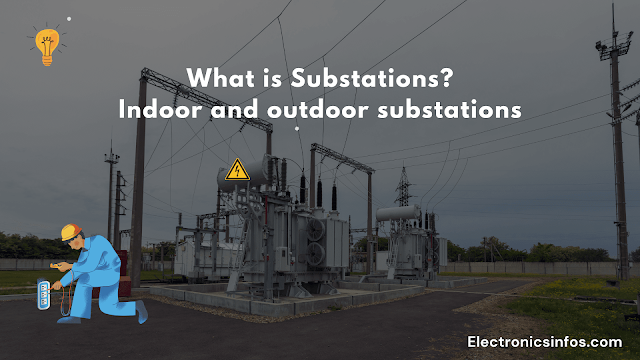 |
| What are substations? |
A substation, also known as a power substation or electrical substation, is a station that helps to control and regulate the flow of electrical power.
What is needed for substations?
A substation receives high-voltage electrical power from the transmission system and converts it to lower voltages suitable for distribution to consumers. It also houses equipment such as transformers, switchgear, and protective relays that help to manage the flow of electricity and protect the power grid from outages, faults, and other disruptions.
Substations can be found throughout the power grid, from urban areas to remote regions.
in some places, we need to change the AC voltage to DC voltage ( Power conversion)change the frequency and change the power factor, these types of work are held in a single point called a substation. The substation is an important part of the power plant to ensure the continuity of the supply. when we construct a substation we must remember some points is
- A substation is near the load centre
- The place of the substation is protective and durable
- maintenance of the substation is easy
Function of Substation
- Substations provide electrical energy all the time to their consumers.
- Substations protect the electrical system and Components.
- The Function of the Substation is to cover the maximum area of the load.
- Substations minimize the fault time to trace the Fault.
- Substations regulate the efficiency of plants and Electrical networks.
- it regulates the frequency of electrical power.
- It provides low-cost energy to its consumers.
- Substations protect the transmission system.
- It controls the energy conversion.
- Substations provide stability.
- The substation regulates the system frequency.
- The Purpose of the substation is to regulate the load sheadings.
- Substation économically divides the load.
- The substation supervises the whole electrical system.
Types of Substation
- W.r.t Service
- W.r.t Design
W.r.t Service
- Step-up Transformer Substation
- Transmission or Primary Substation
- Sub Transmission or Secondary Sub Station
- distribution Substation
- Industrial Sub Station
- Switching Sub Station
- Synchronous Substation
- Frequency Changer SubStation
- Converting Substation
Step-up Transformer Substation
A step-up transformer substation is an important component in the electrical power distribution system, The purpose of a step-up transformer substation is to increase the voltage before it is transmitted over long distances. Step-up transformer substations are commonly located near power plants to boost the voltage for long-distance transmission. There are different advantages of step-up transformer substation is
- Efficient Transmission
- Flexibility
- Safety
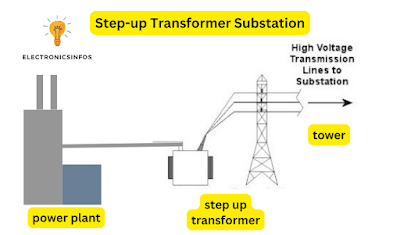 |
| Step-up Transmission substations |
Transmission or Primary Substation
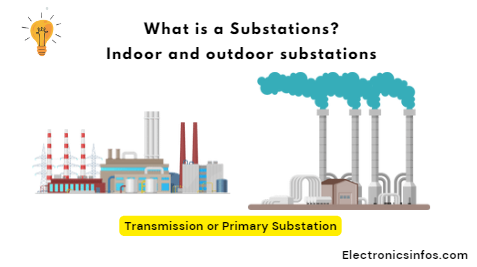 |
| primary substations |
Sub Transmission or Secondary Sub Station
The secondary substation is a type of substation in which we step down the primary transmission voltage into a secondary voltage and then forward it to the load points In this type of substation we step down the voltage further for primary distribution.
 |
| secondary substations |
Distribution Substation
A distribution substation is a type of substation used where we step down the further voltage to the required supply voltage is called distribution substations.
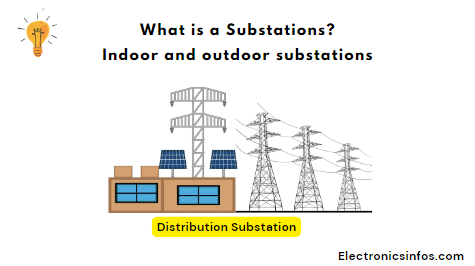 |
| Distribution substations |
A distribution substation is a key component in the electrical power grid that serves to transform and distribute electricity from the transmission system to the end-users, such as residential, commercial, and industrial customers.
Industrial Sub Station
An industrial substation is a type of substation specially designed for industrial consumers. Its purpose is a central hub for receiving, transforming, and distributing electrical power within an industrial setting.
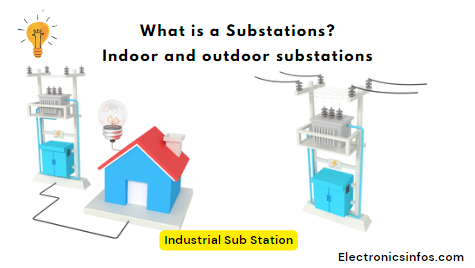 |
| industrial substations |
Switching Sub Station
A switching substation, also known as a switchyard or switchgear substation, is responsible for controlling and directing the flow of electricity. This type of substation primarily deals with switching operations involving various electrical components, such as circuit breakers, switches, and Isolators.
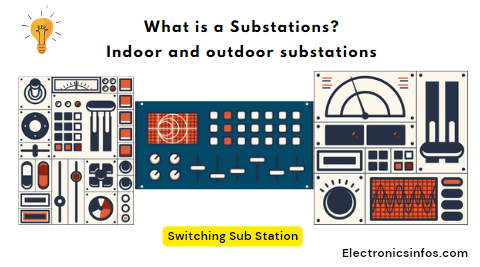 |
| switching substations |
The main purpose is to enable the safe and efficient transfer of electrical power between different parts of the grid.
Synchronous Substation
A synchronous Substation is a type of substation that is used to improve the power factor of the system. Normally this type of substation is constructed at the end of transmission lines. these substations consist of capacitor banks, synchronous motors, synchronous condensers etc
Synchronous condensers contribute to voltage regulation by supplying or absorbing reactive power as needed. The operation of synchronous condensers allows for power factor correction, ensuring that the ratio of real power (active power) to apparent power is optimized.
Frequency Changer SubStation
A Frequency Changer Substation, also known as an interconnecting substation, is to convert electrical power from one frequency to another. The primary purpose of a frequency changer substation is to enable the smooth transfer of power between systems operating at distinct frequencies.
The main element of a frequency changer substation is the frequency converter unit. This unit consists of power electronic devices such as converters or inverters etc. In modern frequency changer substations, Voltage Source Converter (VSC) technology is used.
Converting Substation
A converting Substation is a type of substation where we convert an AC supply to a DC supply is called converting substation. This DC supply is used for different purposes for example reactions, electroplating, electric welding, DC motors etc. Converting substations plays a crucial role in ensuring efficiency within the power system. One common function of a converting substation is to change the voltage level of the incoming power.
Converting substations may also be responsible for changing the mode of transmission, such as converting AC power to direct current (DC) or vice versa. Transformers are fundamental components of converting substations.
Converting substations include protection devices such as relays, fuses, and circuit breakers to safeguard the equipment.
Mobile Substation
The mobile substation is a type of substation that is constructed for special purposes because this type of substation is moveable and is called a mobile substation. This type of substation is used for temporary purposes like construction purposes etc
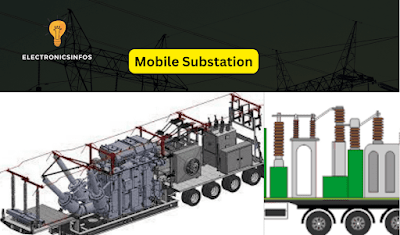 |
| Mobile substations |
W.r.t Design
There are two types of substation w.r.t design which including
Indoor Sub Station
An indoor Substation is a type of substation that is constructed within buildings that's Why this name is given to substations. The indoor substation is constructed in a populated city. indoor substation constructs up to 11kv voltage. this is very typical of substations that are commonly used in a system. there are many compartments in the indoor substations i.e. control department, metering, measurements etc. indoor substation consists of different types of electrical devices to protect and supervise the system. we use circuit breakers, fuses, isolators, insulators, relays, lightning arresters, dampers etc
 |
| indoor substations |
Advantages of Indoor Substation
- The indoor substation is protected from pollution and contaminated air.
- Indoor substation is protected by external temperature and weather conditions.
- In Indoor substation fault level is minimal so no need for major maintenance.
- Indoor substations are normally constructed within populated areas.
- The lifetime of indoor substations is higher as compared to outdoor.
- it provides high reliability.
- Indoor substations require proper design so look-wise is great.
- Indoor substations require less space as compared to outdoor substations.
Disadvantages of Indoor Substation
- The initial cost of the indoor substation is high.
- In the indoor substation fault tracking is difficult.
- Indoor substation extensions are difficult as compared to outdoor.
- Indoor substations normally do not construct more than 66kv.
- The Initial cost of switchgear is high.
- it needs more maintenance cost as compared to outdoor substation.
- It's complex in construction.
Outdoor Sub Station
An outdoor substation is an electrical power distribution system that is designed to be installed in an open-air environment. typically enclosed by fences for safety and security. These substations serve various purposes within the power grid and are configured to withstand environmental conditions. Outdoor substations contain transformers, which may be either step-up transformers (increasing voltage for transmission) or step-down transformers (reducing voltage for distribution to consumers). The transformers are often housed within protective enclosures to shield them from weather conditions and provide additional safety.
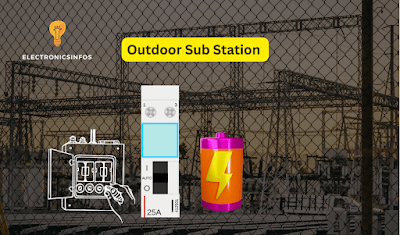 |
| outdoor substations |
Switchgear and protective devices, such as circuit breakers and fuses, are integral components of outdoor substations. Busbars, which are conductive bars or systems for distributing electricity within the substation, are present in outdoor installations. Outdoor substations may include support structures such as gantries or lattice towers to carry overhead power lines.
Modern outdoor substations are equipped with monitoring and control systems that enable remote monitoring of equipment performance. This includes supervisory control and data acquisition (SCADA) systems. There are two types of outdoor substation is
- Pole Mounted Substation
- Foundation Mounted SubStation
Advantages of Outdoor Substation
- Fault tracing is easy in outdoor substations.
- outdoor substation can easily extended as needed.
- In outdoor substations, less material is required.
- In outdoor substations constructive work is easy.
- The Switchgear Cost of the outdoor substation is minimal.
- outdoor substation is simple and needs less maintenance.
- outdoor substation can be constructed more than 66kv.
- The initial cost of the outdoor substation is minimal as compared to indoor.
- maintenance is easy in outdoor substations.
- outdoor substation is popular and reliable.
Disadvantages of Outdoor Substation
- It Requires more space as compared to the indoor substation.
- Temperature and weather conditions affect the system.
- we need more space between the electrical devices in the outdoor substation.
- outdoor substations are normally not constructed in populated areas.
Conclusions
Substations play an important role in the distribution system. The selection of a particular substation depends upon the usage of the system, cost, working voltage etc. The primary purpose of the substation is to control and monitor the electrical system. substation ensures the safety and overall performance of the system.
Frequently Asked Questions – FAQs
What are Indoor Substations?
What are Outdoor Substations?
How do Indoor and Outdoor Substations differ?
Can the equipment of Substations be easily repaired or replaced?
Related Posts





0 Comments
please do not insert spam links